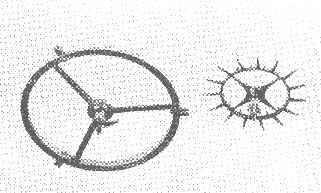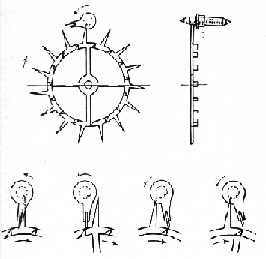 127. Duplex escape wheel, staff and balance
127. Duplex escape wheel, staff and balanceDUMB - REPEATER. A repeating watch, the hammers for the hours and quarters striking upon a block in the case or the case itself instead of a bell or gongs. It was introduced by Julien Le Roy in about 1750.
DUPLEX-ESCAPEMENT. An escapement with two wheels on the same arbor, or - and this is far more commonly
found - an escape wheel with two sets of teeth; one set for locking and one for giving impulse. It is a single-beat,
frictional rest escapement. See Fig. II and Pl. 127. Long pointed teeth on the periphery of the escape wheel lock or rest
against a hollow ruby cylinder fitted to the balance staff, and planted so that it arrests the teeth in their path. Cut in this
cylinder or roller is a notch through which a tooth may pass (escape) when the balance is travelling in the opposite
direction to that in which the escape wheel rotates.
As a tooth is unlocked and escapes, a long finger (the impulse pallet) mounted on the balance staff above the roller
receives an impulse from one of the shorter teeth which stand up from the face of the wheel and which are in the same
plane as the im- pulse pallet. Impulse completed, the next pointed tooth drops on to the roller where it rides while the
balance completes its swing - the supplementary arc. On the return swing, the roller notch slips past the tooth at rest on
the roller without allowing it to escape. Hence there is impulse in one direction only - when escape wheel and balance
are travelling in opposite directions. Jean-Baptiste Dutertre (1715 - 42) invented the duplex escapement in its first form,
Pierre Le Roy giving it the form in which we know it in about 1750. Thomas Tyrer patented it in England in 1782, No
1311. It was particularly popular in England for high grade watches during the first three decades of the 19th century.
 127. Duplex escape wheel, staff and balance
127. Duplex escape wheel, staff and balance
 Fig. II. Duplex escapement
Fig. II. Duplex escapement
DUST-CAP. A cap to exclude dust fitted over the movement of pair-cased watches where the move- ment is hinged to
the case. Dust-caps came into use in about 1715, and may have been introduced by George Graham. They are usually
made of brass though occasionally of silver. Dust-caps are confined mainly to English watches.
DUTCH FORGERIES. Following the investigations of Mr J. H. Leopold of Groningen, our ideas re- garding the
so-called 'Dutch forgeries' must be recast. It appears certain that during the second half of the 18th century there was a
large export trade organised in Geneva which supplied inferior quality watches, many with spurious English names -
and some even with forged English hallmarks - to England, Holland, Germany and other countries. Since many of these
watches had dials with an arcaded minute band which had become popular among Dutch makers in the earlier part of
the century, such watches have for long been thought to have originated in Holland, thus earning for that country the
unenviable reputation which truly belongs to the city of Geneva. The situation is, however, further confused by the fact
that painted enamel dials, made in Geneva, were exported and appear on genuine English movements. Similarly,
inferior repousse cases were exported and were used in the importing country.
Further, Swiss movements were fitted into hallmarked English cases in Holland. The whole complex, therefore, was
one of merchandising rather than watchmaking. The watches in question are recognisable by inferior workmanship, a
bridge rather than a balance cock, a curious maker's name without a Christian name or initial, and an arcaded minute
band to the dial.